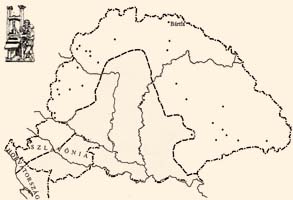 The first continuously operating printing house was established by David Gutgesell in the Upper Hungarian town of Bártfa (present-day Bardejov), near the Polish border, where Gutgesell was a respected citizen, who also acted as a councillor and judge.
The first continuously operating printing house was established by David Gutgesell in the Upper Hungarian town of Bártfa (present-day Bardejov), near the Polish border, where Gutgesell was a respected citizen, who also acted as a councillor and judge.
Gutgesell enjoyed full local support, as his press added to the prestige of the free royal town. His was the first printing house running with the emperor's and king's privilege obtained in 1584. What is more, later on too there was no other Hungarian printing house with an operating licence in the hands of Protestants.
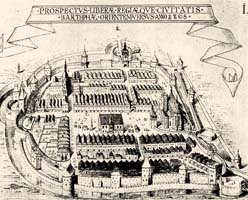 Gutgesell mastered the skills of printing in Vienna, and as we learn from a note addressed to Rudolph II, he "practised this art of book printing in several towns of the Sacred Roman Empire". It is certain that in 1570, seven years prior to returning to Bártfa and setting up his own press, he visited the Polish town of Wroclaw, and made contact with the famous printer Crispin Scharffenberg.
Gutgesell mastered the skills of printing in Vienna, and as we learn from a note addressed to Rudolph II, he "practised this art of book printing in several towns of the Sacred Roman Empire". It is certain that in 1570, seven years prior to returning to Bártfa and setting up his own press, he visited the Polish town of Wroclaw, and made contact with the famous printer Crispin Scharffenberg.
At its start, the press had very favourable circumstances. Bártfa had very lively trade links with the nearby town of Cracow, the capital of Poland at the time, as well as with Silesia, Vienna and all the other Upper Hungarian settlements. It needs to be added that during the Turkish occupation, trade between Transylvania and the West was diverted to the Kassa -Bártfa-Cracow-Wroclaw route rather than going through Buda and Vienna.
Gutgesell himself also had contacts with Cracow. The letter types he used for printing his books seem to be identical with those of the Cracowian Andreas Petricovius. Consequently, they were either made in Cracow, or both came from the same source.
The first time the town stood up in support of Gutgesell was when in the first years his printing house worked without the Emperor's licence. And the town was behind the printer again when in 1588 the authorities noticed that even after the calendar reform (ordered by the Pope) he went on producing the old calendar. In his decree of 28th August 1588, Emperor and Hungarian King Rudolph ordered Bártfa to have the press closed down, which however the town failed to comply with.
In 1589 Gutgesell had in his house Salomon Sultzer from Höchstedt, who modernised the printing equipment they used. He had come from Vienna to Bártfa, and subsequently went on to a number of other towns in Hungary: He worked for the Debrecen press (1590) and in 1591 wrote to Lőcs (present-day Levoča) from Kőszeg, offering his services as the town's master printer. Later, Sultzer set up his own workshop in Vilna in Poland.
Protestant printers in Hungary insisted on the pre-reform calendar, and published a calendar that featured the old and the new calculations of time in parallel. So did Gutgesell himself.
Under the name of Judicium, his Hungarian calendars were published annually.
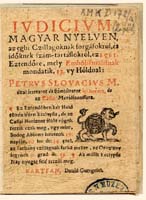 |
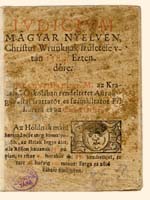 |
RMNy 449 |
RMNy 604 |
|
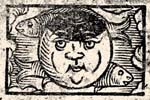 |
Two modest illustrations: a sign of the zodiac with a lion and a representation of the Moon. |
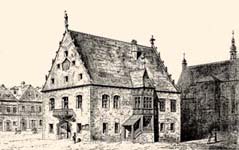 |
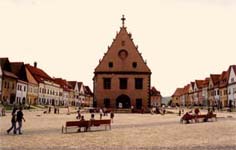 |
The Town Hall in the middle of the town's main square then -- and now (Bardejov, SK) |
During his over twenty years of activity, Gutgesell issued at least 80 publications, with such lengthy works among them as two editions of György Kulcsár's Hungarian preaching and his Protestant Book of Psalms (1593).
In addition to Biblical stories in Hungarian, a Protestant catechism in Biblical Czech (1581), and a German Biblical history in verse (1580) also came out of his press
He also published Bálint Balassi's translation of the Herbal Booklet for Sick Souls
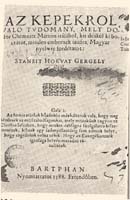 |
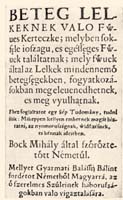 |
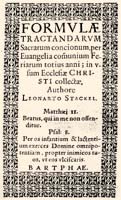 |
RMNy 603 |
RMNy 446 |
RMNy 406 |
This is where a number of Lutheran religious pamphlets were also brought out. When the plan of printing Gáspár Károli's Calvinist Bible translation aroused, Bártfa as printing site was one of the options, but the idea soon had to be dropped probably because of Gutgesell's and the town's strong Lutheran faith. That is why eventually the translation was printed by Mantskovit in Vizsoly .
According to the Latin text in the frame, this book was issued and printed in Bártfa by David Gutegesell.
Gutgesell's publications used highly attractive letter types, but were made with very few decorations.
His books were decorated by printers' flowers, often compiling out of them a decorative frame for the title page.
Besides the end pieces and cast printers' flowers, the evenly printed and nicely laid out texts are made more varied by initials varying in three sizes.
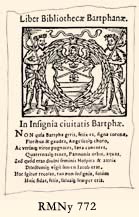 The woodcut crest of the town of Bártfa, however, is a specially made book decoration. In the centre of the rectangular frame there is the crest enclosed in a laurel wreath. This coat of arms is held by an angel, and the wreath with ribbons in four places is surrounded by a wild man with two flags. Gutgesell used this wood-cut for decorating title pages too, and the same cut decorates the book-plate (ex libris) of the first Hungarian public library in Hungary, that of the free royal town Bártfa. This is the earliest printed ex libris in Hungary, and is therefore unique.
The woodcut crest of the town of Bártfa, however, is a specially made book decoration. In the centre of the rectangular frame there is the crest enclosed in a laurel wreath. This coat of arms is held by an angel, and the wreath with ribbons in four places is surrounded by a wild man with two flags. Gutgesell used this wood-cut for decorating title pages too, and the same cut decorates the book-plate (ex libris) of the first Hungarian public library in Hungary, that of the free royal town Bártfa. This is the earliest printed ex libris in Hungary, and is therefore unique.
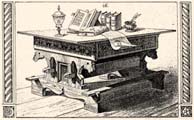 The last publications of Gutgesell's press date back to 1599. After his death, he had no heir to continue the printing trade. In the last three years of his active life between 1597 and 1599, there was another printer Jakob Klöss working in Bártfa, using his own typography. It is noteworthy, as in those times very rarely occured that there were two presses operating in the same town.
The last publications of Gutgesell's press date back to 1599. After his death, he had no heir to continue the printing trade. In the last three years of his active life between 1597 and 1599, there was another printer Jakob Klöss working in Bártfa, using his own typography. It is noteworthy, as in those times very rarely occured that there were two presses operating in the same town.
Gutgesell's characteristically cut letters, which were then still in excellent condition, are not seen in any Hungarian workshop, so they must have been smelted down. The situation is different with his book decorations, which could not be smelted. After over a decade, they turned up again in the 1610s, when the other Bártfa printer's, Klöss' son-in-law continued to use them in his printing house.
 From his son-in-law Johann Fischer, Gutgesell's decorations and initials were taken over by Fest. However, the plate representing the crest with the wild men to guard Bártfa, vanished.
From his son-in-law Johann Fischer, Gutgesell's decorations and initials were taken over by Fest. However, the plate representing the crest with the wild men to guard Bártfa, vanished.
 This was not the end of the history of Gutgesell's decorations. From Kassa (present-day Košice), the initials were passed on to the newly set up Brewer-press in Lőcse (present-day Levoča). Even as late as 1729, over 150 years after Gutgesell had established his workshop in Bártfa, the pieces of the smallest initial series were still in use in the Brewer press.
This was not the end of the history of Gutgesell's decorations. From Kassa (present-day Košice), the initials were passed on to the newly set up Brewer-press in Lőcse (present-day Levoča). Even as late as 1729, over 150 years after Gutgesell had established his workshop in Bártfa, the pieces of the smallest initial series were still in use in the Brewer press.

The main church of Bártfa in its medieval form.
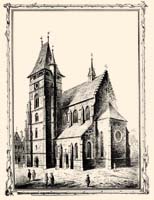
There is a note in the town's books that during the time of David Gutgesell as the judge of Bártfa, in 1574 the "Orbán bell" was made by the bell-founder master János from Tarnow.
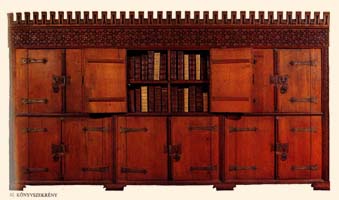 This medieval lime-tree bookcase survived in the vestry of the Bártfa main church, where the church's books were kept, perhaps with those among them which had come out of local printers' hands.
This medieval lime-tree bookcase survived in the vestry of the Bártfa main church, where the church's books were kept, perhaps with those among them which had come out of local printers' hands.
- Connection - Publications - Illustration - Printer's flowers - Initials - Printing types -
<<back to the top <<

LITERATURE:
V. Ecsedy Judit: A könyvnyomtatás Magyarországon a kézisajtó korában 1473-1800. Bp. 1999.
Repcák, Jozef, Prehlad dejin knihtlace na Slovensku. Bratislava 1948.
Valach, Július, Staré tlaciarne a tlaciari na Slovensku. Martin 1987.
Borsa Gedeon, Salomon Sultzer ein Typograph und Schriftgiesser in Mittel- und Osteuropa (1564-1603), Acta Litteraria 1971, 43-47.